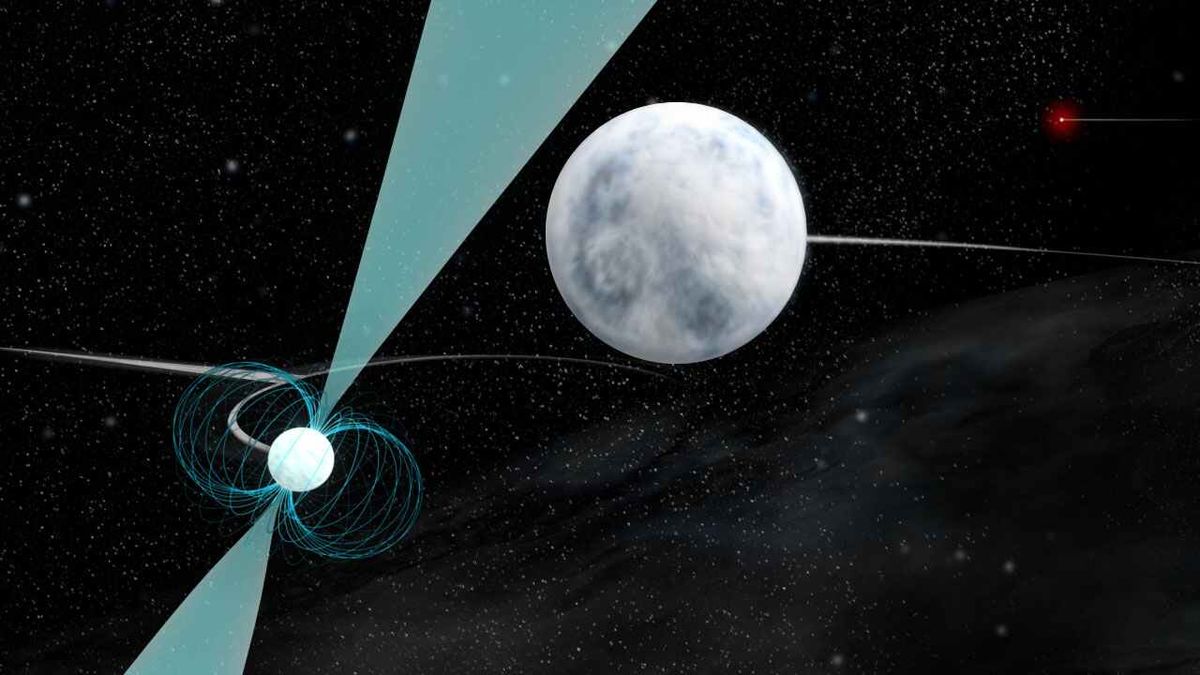Fast-Spinning Star Tests Einstein's General Relativity Theory

A unique triple-star system may help scientists resolve some of the gravitational conflicts behind general relativity and alternate theories of gravity.
A dense, fast-spinning star known as a millisecond pulsar closely orbits one white dwarf star, as the pair treks around a second white dwarf. The three stars are crammed into a region of space smaller than Earth's orbit around the sun.
"This is the first millisecond pulsar found in such a system, and we immediately recognized that it provides us a tremendous opportunity to study the effects of gravity," lead author Scott Ransom of the National Radio Astronomy Observatory (NRAO) said in a statement. [6 Weird Facts About Gravity]
"This triple system gives us a natural cosmic laboratory far better than anything found before for learning exactly how such three-body systems work, and potentially for detecting problems with general relativity that physicists expect to see under extreme conditions," Ransom added.
A unique system
When a massive star explodes in a violent supernova, the remaining core can be transformed into a fast-spinning object known as a neutron star. These incredibly dense stars pack the mass of 1.4 suns into a space roughly the size of Washington, D.C.
If such a neutron star also spins, it is known as a pulsar; exceptionally fast-spinning stars are known as millisecond pulsars.
Sign up for the Live Science daily newsletter now
Get the world’s most fascinating discoveries delivered straight to your inbox.
Lying 4,200 light-years from Earth, the millisecond pulsar PSR J0337+1715 spins 366 times per second, emitting radio waves much like a lighthouse emits visible light. The fast-spinning star was discovered in 2011 as part of a large-scale search for pulsars using the NRAO's Green Bank Telescope by graduate student Jason Boyles, then at West Virginia University. Scientists quickly realized that the pulsar was in orbit with two dead stars known as white dwarfs.
"The gravitational perturbations imposed on each member of this system by the others are incredibly pure and strong," Ransom said. "The millisecond pulsar serves as an extremely powerful tool for measuring those perturbations incredibly well."
Precision timing of the pulses from the spinning star allowed the scientists to compute details of the system. [Top 10 Star Mysteries]
"We have made some of the most accurate measurements of masses in astrophysics," study team member Anne Archibald, of the Netherlands Institute for Radio Astronomy, said in the same statement.
"Some of our measurements of the relative positions of the stars in the system are accurate to hundreds of meters," Archibald said.
The true nature of gravity
When Albert Einstein published his general theory of relativity in 1905, he defined gravity as a distortion of space-time by massive objects. But subsequent discoveries have led to attempts to develop a better understanding of the force.
The newly discovered triple system will allow scientists to study a violation of a concept known as the equivalence principle, which states that gravity's effects do not depend on the nature or internal structure of a body.
The most well-known example of this concept comes from the story wherein Italian astronomer Galileo Galilei reputedly dropped two balls of different masses from the top of the Leaning Tower of Pisa, though there is no historical conformation of the famous tale. In 1971, Apollo 15 Commander Dave Scott performed a similar experiment when he dropped a falcon feather and a hammer on the airless surface of the moon.
The same fast pulses that allowed Ransom's team to measure precisely the movement of the stars can also create a real-life gravitational laboratory.
When the remains of the massive progenitor star collapse into a neutron star, some of the mass is converted into gravitational binding energy that holds the super-dense star together. According to the strong equivalence principle, the binding energy will react gravitationally as mass, while the alternatives to general relativity say that it will not.
"This system offers the best test yet of which is the case," Ransom said.
If Einstein's theory is correct in all cases, the gravitational effect of the outer white dwarf would be identical for both the inner white dwarf and the neutron star. But if the strong equivalence principle is invalid, the outer star's gravitational effects on the inner system would be slightly different for each star.
High-precision timing of the pulses would allow scientists to test for deviations from the strong equivalence principle far more precisely than has ever been possible, a deviation that would lead to a greater understanding of gravity, researchers said.
"This is a fascinating system in many ways, including what must have been a completely crazy formation history, and we have much work to do to fully understand it," Ransom said.
Follow us @Spacedotcom, Facebook or Google+. Originally published on SPACE.com.












